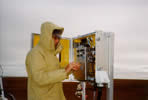Is mercury a significant contaminant in the Arctic?
Is the Arctic a missing sink for
mercury?:
New measurements of mercury speciation and depletion events at Point
Barrow
Steve Lindberg
Oak Ridge National Laboratory
and
Steve Brooks
NOAA / Air Resources Laboratory
In the past decade many new sources of diffuse mercury emissions have been measured. These sources significantly increase the estimates of global mercury emissions, and suggest there may be missing mercury sinks in global models. Mercury levels in Arctic wildlife are elevated above normal levels, but there are few known Arctic mercury sources, and long range transport of mercury must be considered. The discovery of mercury depletion events (MDE, similar to ozone depletion) at Alert, NWT suggests a mechanism for mercury accumulation from the global pool. One hypothesis is that mercury is transformed into a reactive gaseous mercury (RGM) species which deposits locally. This species has never been measured in the Arctic, and MDE's must be confirmed at other Arctic sites.
  |
|
| Steve Brooks of NOAA and Steve Lindberg of ORNL set up a denuder system [1] to measure atmospheric mercury speciation at the CMDL Point Barrow Observatory in Alaska. |
As part of the Barrow Arctic Mercury Study (BAMS), we have measured gaseous elemental mercury (GEM) at Barrow, AK since September, 1998 with an automated Tekran analyzer [1]. The initial data provide the first confirmation of MDE's at this more southerly, Arctic site. MDE events begin soon after Polar sunrise, and persist until snowmelt. During MDE mercury exhibits a strong correlation with ozone, suggesting a link with the reactions that destroy tropospheric ozone. We have developed a simple model using local meteorological data which closely simulates the patterns of depletion events, and suggests that turbulence and temperature are important factors. There are a number of potential reaction pathways with mercury and bromine to explain the depletion events, which suggest that during these events mercury is oxidized to RGM. The model predicts a mercury deposition rate much higher than measured in the eastern US. To test our hypotheses, we are currently measuring RGM prior to and following polar sunrise during winter-spring 2000, and plan to measure mercury speciation and evasion in snowmelt during polar summer. The winter-spring 2000 RGM data are just now becoming available and represent the first confirmation of important rates of conversion of GEM to RGM in the Arctic. At Barrow we have recently measured some of the highest concentrations of RGM ever reported, including downwind of major point sources. To follow up on this important discovery, we are planning a major sampling campaign for next year: BAMS-2001 will include studies of reactive halogens and particulate mercury by Bob Stevens and Matt Landis of EPA-NERL, evasion from snowpack by Hong Zhang and George Sourhworth of ORNL, mercury dynamics in snow including studies of organic and bioavailable mercury by Karen Scott, John Rudd, and Carol Kelly of the University of Manitoba, and modeling of atmospheric reactions of mercury by Jerry Lin of Lamar University.
References:
CMDL Point
Barrow Observatory
News
article on mercury in the Arctic
Long
range transport and transformation of mercury to the Arctic
[1] Researchers use a newly
developed system to sample reactive gaseous mercury (RGM) in air.
An annular denuder, developed by Tekran Inc. and the USEPA, is used
to strip (denude) the reactive mercury gas species from the sampled
air stream while allowing the non-reactive gaseous elemental mercury
(GEM) species to pass through unsampled. The denuder is them heated
to more than 500°C to desorb the RGM and convert it to GEM where
it is detected by a Tekran GEM analyzer operating in the NOAA CMDL
building.
Research sponsored by NOAA and the US EPA OIP under contract with
ORNL. ORNL is managed by Battelle Institute and the University of
Tennessee for the U.S. Department of Energy. Return to article here.
Speakers address: Oak Ridge National Laboratory, PO Box 2008, Oak Ridge, TN 37831-6038, USA. Email: SLL@ornl.gov. Research Web Page and fax: 867-576-8646.




